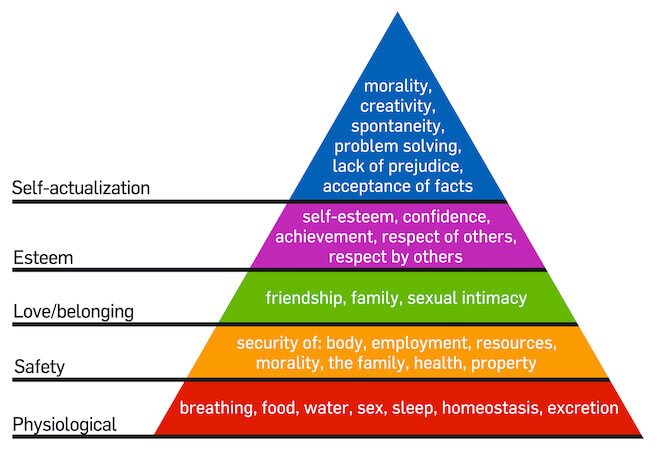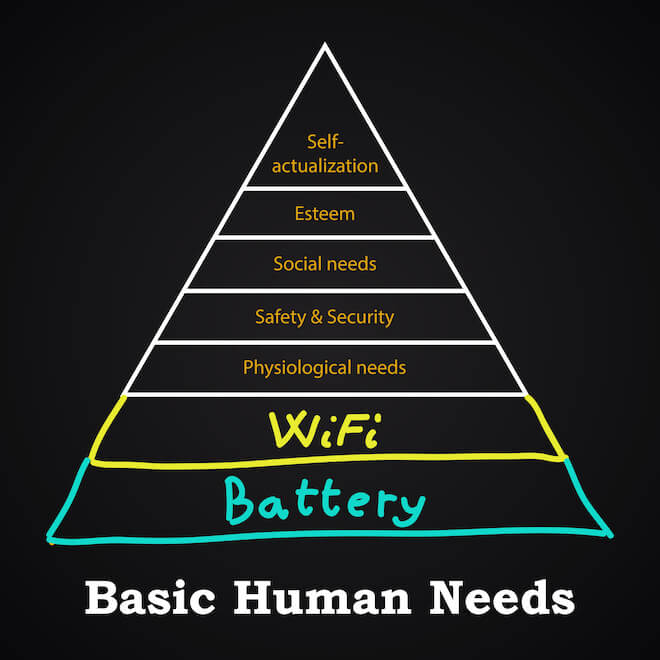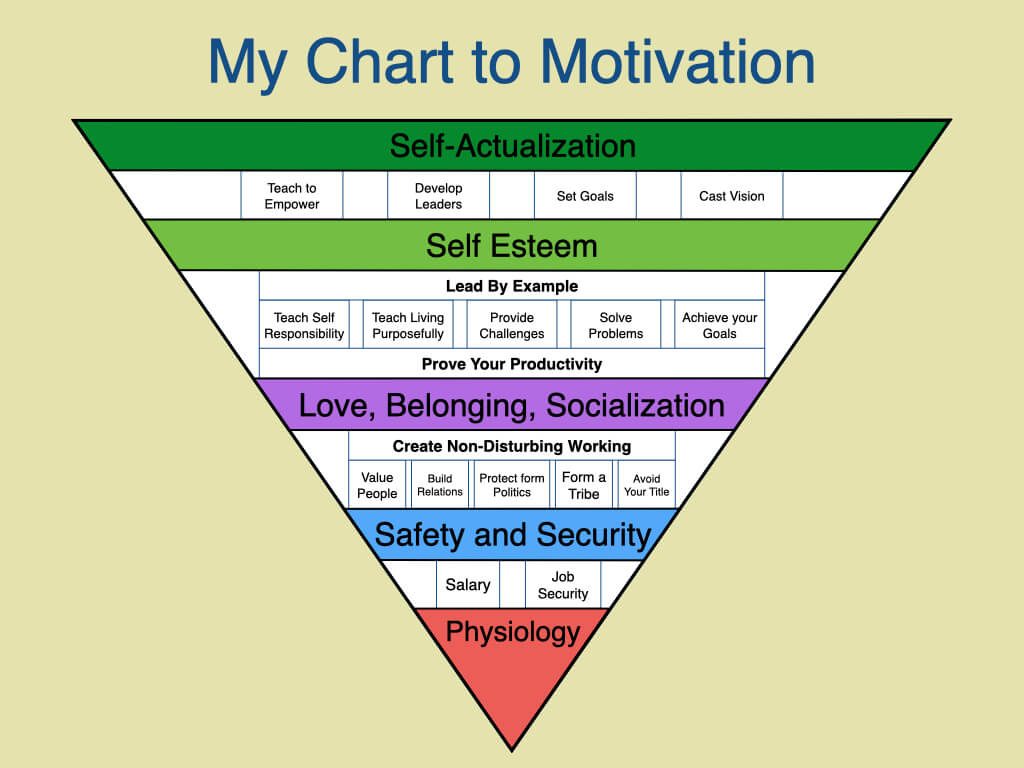Understanding the Maslow’s Hierarchy of Needs will help you better understand how to motivate your project team. It’s still one of the theories tested during the PMI PMP exam.
Maslow’s theory describes the pattern of how human motivation develops.
Nowadays, the theory is represented as a pyramid. For sure, you have already seen it many times:

or at least you must have seen this one:

The main actionable item from the theory is this:
Motivational and leadership approaches and techniques from higher levels are NOT efficient when lower levels are compromised.
In other words, you cannot improve a person’s motivation on a higher level until his lower-level needs are satisfied.
So, for example, giving additional responsibilities won’t motivate a person who’s struggling to put food on the table. You need to provide him with a decent salary first.
But it will work for a person who’s already looking to increase self-esteem.
My 5 Levels of Maslow’s Hierarchy of Needs
Frankly speaking, I believe that you need to invert the pyramid:

Our basic needs don’t actually take that much space in our life.
But on the other hand:
You need much more effort to motivate someone on a high-level in the hierarchy.
So, how can you, as a project manager, use this?
I’ve got five simple rules for you:
#1: Always Keep in Mind Physiological Needs
Yeah, it sounds like you can skip it.
You may think that you don’t work in an environment with severe poverty or some disaster areas, so it is insignificant.
But that’s not true.
Modern cities and offices have transformed our physiological needs.
Take a look around:
Water cooler, cakes, coffee and tea, toilets, stores with food.
You take it for granted, that’s why you don’t notice it!
However, the next time the toilet in the office is out of order or water delivery delays, do notice the amount of rumbling in the office.
Even if people take it stoically, I do not recommend planning any team-building activities.
Most of your efforts will be wasted or inefficient. So, in such cases, you better focus on overcoming these small inconveniences.
Example of Physiological Needs
On the lowest level of needs are the things required for survival.
These include:
- Air
- Water
- Food
- Sleep
- WiFi 😀
Anything that our body needs to operate.
By the way, lack of good sleep is a hit on Physiological Needs.
You’ll see it with the project team members who have newborns. They won’t be motivated by new challenges until they hit the bunk.
Don’t Undermine Safety and Security Needs
Once you are relatively fed and warm, the safety kicks in.
People start looking for a safe and secure shelter to sleep and live. They look for stability and predictability in life and at work.
Always remember that safety needs are personal.
For example. Someone thinks we need a certain level of humidity in the office. You think it’s a trivial issue. In any case, you shouldn’t ignore or undermine that person’s concerns.
However, again, for most of us, this need had transformed from physical safety to financial safety.
Example of Safety Needs
While we have a stable income, we can pay for food, rent, insurance, and are able to fulfill other needs.
Take away the money and other social securities – and the next thing your mind draws is a disturbing picture of where you need to hunt your food.
That’s why threats related to firing a person never motivate.
Moreover, when you try to penalize a person, it also has a little positive effect.
Also, delays in salary are a long-term hit on motivation because people will be afraid that payouts will be delayed next month.
Even such a small thing as uncertainty about when the money gets to your account is a demotivator!
Here’s what you need to understand about people who already been on a higher level of the hierarchy.
(And basically that’s all of them.)
When you deprive your employee of financial stability, the immediate reaction is to regain it.
How?
We do not tend to eliminate the threat and fix problems. It is too risky.
We tend to substitute the income source by finding a new job. If there’s a high demand in the hiring market, you can quickly lose your best employees.
You need to understand that nowadays, financial safety and stability is tightly related to Physiological Needs. So, whenever you endanger safety needs, you make a hit on the lower level as well.
Safety Needs During COVID-19
Also, the overall stability in a country, global economic situation, bad news can all impact our need for safety and security.
The global problems like we have today with COVID-19 require you to work closely with psychological safety needs.
You need to address troubles and thoughts related to the safety and health of your team members.
This safety issue will be nagging people all the time.
When people get back to offices, some of them won’t be happy about it. Moreover, each related bad news will make a hit on motivation.
If you’ll ignore these worries, all your over-motivational efforts are a waste of time.
Build Up Social Belonging All The Time
When the first two needs are met, people want to socialize.
Your team members will want to make friends, connect with colleagues, and create families.
It will happen with or without your participation. However, I do suggest to influence this process actively.
For example, you can and should create a friendly and open environment.
- Encourage professional interactions without your participation.
- Let people network beyond the project team.
- Ensure adequate work-life balance.
- Make office not-for-work-only space.
- Help to resolve conflicts.
- Do project planning together.
- Always help newcomers to adapt.
Likewise, be aware that you may impede this process.
A competitive environment where blaming and politics are a norm makes it hard to socialize.
Moreover, do you know this saying?
“People do not leave companies they leave managers.”
It speaks directly about dysfunction on this very level.
Example of Social Needs
OK, here’s an overall example for the first three levels.
You can observe Maslow’s Hierarchy of Needs for fresh graduates the most.
So, you hire a person. It’s her first-time job. Let’s say her name is Mary.
During the probation period, Mary will be stressed. If she doesn’t get a permanent job, her ability to pay the rent and buy food (physiological needs) will be in danger.
So, she’ll work really hard.
When she passes the probation period, Mary won’t reduce her performance. Usually, on the contrary, she will double up.
Why?
Well, Mary got a taste of the safety and security of a steady income. She’ll try to protect it. So, she’ll do her best to become a valuable employee.
Mary will work hard until she gets to a salary level that will suit her lifestyle. And the one she considers “safe.”
That’s when her priority switches to social needs.
She’ll start dedicating more time and energy to becoming a part of a certain group of people. It may be at work or outside of the work. Or even both.
Here you’ll notice that Mary’s professional development rate drops. You may think that she reached her potential.
But she needs to fulfill her social needs first. Only then Mary will start working on making great achievements to increase her self-esteem.
Hopefully, you’ll be able to drive her energy and motivation toward productive work on your project.
Increase Team Members’ Esteem with Career Development Guidance
At some point, people want to feel respected and valued.
They want accomplishments.
It is not easy to continuously support those feelings. But there are several things you can do daily without much effort:
- Explain the value and importance of any task that you give. Mundane tasks kill self-esteem quickly.
- Say Thank You often. Daily.
- Encourage people to talk about their hobbies and passions. That alone makes them proud. Never criticize or judge these activities.
- Recognize the impact of every team member. Though be careful, not everyone feels comfortable hearing public praise.
- Help people to set and achieve goals. The process of moving towards a challenging goal boosts self-esteem better than anything.
Example of Self-Esteem Needs
The best example of self-esteem needs is our craving for job titles.
Think about it. We have:
- Assistant Project Manager
- Junior Project Manager
- Project Manager
- Senior Project Manager
- Senior Technical Project Manager
- Senior Delivery Manager
- Program Manager
- Technical Program
- Executive Risk Manager
The list goes on and on. Each of the titles promises more authority, more responsibility, and respect.
However, in essence, they mean the same job responsibility. But much more work the higher you get on the ladder.
At some point, salary doesn’t increase proportionally with the amount of work and responsibilities.
But still we want to get that next shiny title.
By the way, I have a video on the career of a project manager. If you want to learn more about possible career options – click that link.
Created Environment for Self-Actualization
Maslow’s theory has some cracks closer to the top. But I don’t think you should worry about it too much.
So, people will want to match their self-esteem with significant achievements. They will want to prove that they are worth something real.
But can you be of use at this level? Yes, for sure!
Lots of team members will NOT know what they want.
Until they understand how to realize their potential, you can help them.
But I want you to understand that there are some problems:
- There will be just a bit of people who are on this level. And most of the time, you’ll be working on your self-esteem level.
- It usually means you need to help a person to achieve something bigger than the work on your project.
You’ll be pushing the person to prioritize something other than the work in the company.
Examples of Self-Actualization Needs
Self-actualization is personal and can be anything a person perceives as valuable:
- Career development
- Authority
- Family and kids
- Sport achievements
- Entrepreneurship
- Creativity
- Charity.
Quite often, it transforms into a need to help others or to follow some higher goal or dream.
Conclusion
Maslow’s Hierarchy of Needs both criticized and overused in project management.
So, does it even work?
Yes, you’ll see it yourself.
If you do not have a background in psychology, you do not need to dive too deep into it. There is no reason to read Maslow’s papers back from 1943.
With an adequate allowance, you have just learned everything you need for practical use. Even if it is not a 100% accurate interpretation, it will be sufficient to improve your motivation efforts.

